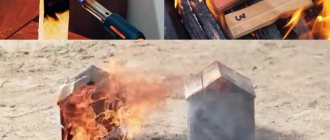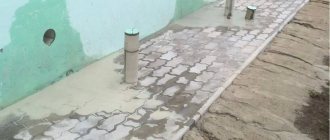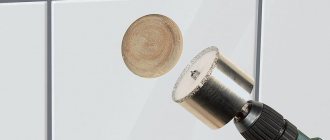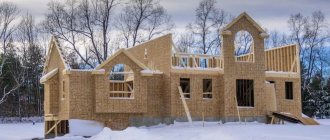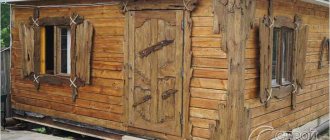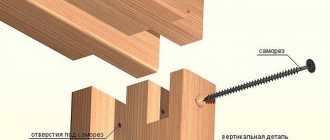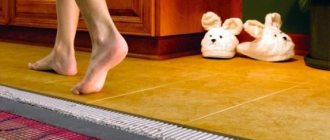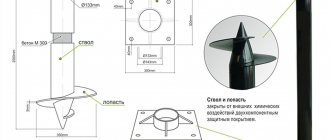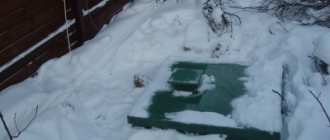When drying wood naturally (this is a long process), another, earlier treatment of unsanded logs is carried out. This should be enough for the construction period.
Pre-treatment by dipping.
Autoclave (vacuum) antiseptic treatment.
After shrinking the house, another stage of processing follows. Its purpose is to preserve the wood, and then a finishing coating is applied, which also has antiseptic properties.
Reasons for the need for winter antiseptics
There are only two such reasons.
The first is the delay in construction. These are most often the consequences of errors:
- when choosing a contractor,
- assigning work to different performers,
- occurrence of financial difficulties for the customer.
In fact, there is only one mistake - the wrong choice of performer. The right contractor does everything and first of all will assess the financial readiness of the customer.
In the photo, 2 years have passed since the initial treatment. There was no next one.
The second reason is poor-quality antiseptic treatment of wood. The fact that the technology for treating wood with a specific antiseptic is the same for everyone does not give the same result. Companies whose activities begin with cutting down forests and ending with building a house take antiseptic treatment more seriously. What has been said in this paragraph is a return to the thesis “the wrong choice of contractor.”
Also several years without a roof and without treatment. Varying degrees of damage to timber are a consequence of violations of antiseptic treatment.
Antiseptic agents for laminated timber
The laminated lumber itself, processed in production, can be coated in one layer with an antiseptic before assembly. Particular attention should be paid to those elements that are located directly close to the ground. Because due to increased humidity, the upper lamellas will begin to rot and crack. Fungi and mold do not like laminated veneer lumber because of the compositions used to connect the lamellas.
Impregnations for vulnerable areas of the house
The most vulnerable places inside the house include:
- Cellars.
- Cellars.
- Lower crowns.
- Subfloor and joists.
These areas can be treated with deep penetration antiseptics after building a house made of timber. These areas need to be antisepticized at least once a year, and more often in particularly wet areas. It is better to take a synthetic-based antiseptic with a strong effect. With their help you can achieve:
- Formation of a deep protective layer that is resistant to washout.
- Protection against moisture penetration into the upper slats.
- Increasing the fire threshold.
These include: Lovin, KSL, Snezh, Neomid. The price for them ranges from 70 to 150 rubles/liter. To save money, you can use drying oil. Drying oil is not suitable for walls, as it tints the laminated timber and spoils the appearance.
Coatings for interior walls
Interior walls are coated with primer, oils or wax. All these compounds are natural and will not damage the appearance of the walls.
Primers for walls
Primers can be transparent or colored; the first option is better suited for building a house made of laminated veneer lumber. Such an antiseptic can prevent the penetration of moisture and the development of fungi. They are used under the finishing coat (varnish or paint). The most popular include:
- Ost 3180 is a transparent primer, quick-drying. Costs from 100 rubles.
- Cosane rosin primer, used under clear coat. Costs from 70 rubles.
- Nitro cellulose primer DD-113. Easy to apply with a brush or spray gun, used under nitrate varnishes. Costs from 110 rubles.
- Casein primer in paste form. Available in transparent and colored versions. Apply to laminated timber using a rubber spatula. Costs from 170 rubles.
Oils for laminated timber
It is better to take natural, cold-pressed oils. Linseed oil will highlight the appearance of walls well. Treating a house made of laminated timber with oils is carried out using veneer, using light movements, rubbing it into the wood in an even layer.
It’s not uncommon to read on forums that baby oil was used for the walls, but its consumption and price will be high. Cold-pressed flaxseed oil can be purchased in large shopping centers. Its price starts from 250 rubles/l.
Wax impregnations
These are the most optimal compositions for the construction of a house made of profiled timber, which are used to process a house made of laminated veneer lumber. They are difficult to apply, but in terms of durability and resistance to mechanical damage, wax ranks first. Modern wax compositions can artificially age a wall or give it a unique shine. At the same time, a protective film is formed on the timber, which does not allow moisture to pass inside. The price of wax for laminated lumber is from 250 rubles/100g.
Antiseptics for external use
Exterior finishing is more important for laminated timber. On the outside, the material must be protected from several factors at once: ultraviolet radiation, moisture, temperature changes, mold and mildew. For each of the harmful factors, their own means have been developed, and they can be of two types: film and impregnating.
Film types include: protective varnishes and paints for wooden structures. Varnishes can prevent the harmful effects of ultraviolet radiation, do not allow moisture to pass through and will preserve the color of the timber. They are produced on a water or chemical basis. Any option is suitable for laminated veneer lumber, since the glue already makes it not entirely environmentally friendly.
Impregnating compounds are antiseptics that provide fire protection and bio-protection of wooden structures. Well suited for external finishing of drying oil. But drying oil will darken the natural color of the wooden material. Such products cost from 50 rubles/l.
Compositions for ends
The most important part of the exterior finishing of a wooden frame is the ends. If they are not processed correctly, water will get inside and the lamellas may come apart. The ends are polished with no. 140 nozzles and sealed with special sealants. Among the sealants for ends, I would like to note: finishing coating for ends Log End Seal, Biotor. The compositions are not cheap, from 270 rubles/l, but their durability is up to 15 years. By covering the ends with them in two layers, you don’t have to worry about the house for a long time.
Background
About 10-15 years ago, builders had no idea about winter antiseptic treatment of log houses. All materials indicated that work was carried out at an ambient temperature of at least +5 degrees. On some, not lower than +10.
Frost is not a factor contributing to biological damage to wood. Rather, on the contrary, it is a natural preservative of these processes. Thawing cycles increase the moisture content of the material, but one cannot speak of a fatal surge in biological activity.
Most likely, the emergence of antiseptics for working at subzero temperatures is a consequence of competition in the Russian building materials market. After the 0 degree mark was crossed in the advertising brochures, a meaningless race began. Now there are applications for the lower limit of work - 25 and -30 degrees.
The work of marketers, carried out according to the principle of “absolute truth”: “A decent person up to 100 years old with up to 32 teeth.”
Mold and insects. The influence of low temperatures on their activity
With the arrival of winter, when the temperature reaches zero, insects fall into suspended animation. Insects do not always die in the cold, and in most cases they easily endure the winter, and become more active when the temperature rises above zero. The peak activity and reproduction of insects occurs at temperatures from +10°C to +35°C.
Mold also stops developing at sub-zero temperatures and activates at positive temperatures, calmly surviving freezing.
The air temperature in different regions of the country fluctuates throughout the winter from minus to plus. This means that insect and mold activity in some cases continues throughout the year.
It is worth considering the unpredictability of the weather, since in winter precipitation may fall in the form of rain or sleet, which can sharply increase air humidity. The risk of damage to wood in such cases reaches 100%. All this leads to additional costs in the spring associated with sanding wood and treating with antiseptics.
Of course, wood is subject to restoration and subsequent use, but if basic rules of protection are constantly neglected, its service life is reduced.
Having answered the question about the need to use an antiseptic, let's look directly at the compositions themselves.
Difficulties of work
Regardless of any declared frost resistance figures, the requirements for low wood moisture content remain constant. There is a condition that the wood should not be frozen; an obligatory part of the work is cleaning it from frost and ice. Recommendations for the use of concentrates include instructions for diluting with hot water or adding antifreeze. This is labor-intensive and costly work. Moreover, their implementation is difficult to monitor.
The antiseptic process involves the penetration of reagents to a certain depth. Invisible, but existing in winter, ice crystals clog the pores of the tree and become barriers to their passage.
There are reviews on the Internet about good results of winter work when the concentration of antiseptic is increased, but in this case the sanitary and hygienic certificate is in doubt. The concentration in it is assumed to be fixed.
An absolutely human factor - it is difficult to convince people that treating wood with an aqueous solution at -20 is not the whim of a crazy foreman.
Types of wood processing
A number of manufacturers process materials in factories, supplying already processed products for residential construction. But there is also the option of treating with an antiseptic at home.
Treatment of walls inside a wooden frame
After finishing the processing of wood materials and subsequent construction of the house, additional external treatment will be required for the walls of the house (both indoors and on the street side), flooring and all carved wooden partitions that may come into contact with water.
All of the listed types of objects have their own special type of impregnation, which will help preserve them in excellent quality during the use of the living space for a very long period.
Wood materials must be subjected to primary antiseptic treatment for the reason that building a house will take quite a long time. Construction materials will be stored outdoors and will encounter many unfavorable factors that will affect their condition.
At this stage, it is necessary to treat the walls with a hard-to-wash antiseptic, which can protect the wood inside and outside the room from external factors for 2-8 months and will not affect the color or properties of the wood in any way. Do not forget that wood materials must be stored on special pads to avoid contact with the ground, which will also negatively affect their condition.
Today there are many types of antiseptics, which can be divided into 3 groups:
- aquatic;
- oil;
- chemical.
Before treating with an antiseptic, you will need to calculate the area of the surface to be treated. The manuals for all antiseptics include information about the consumption of antiseptic per 1 meter. This will allow you to accurately calculate the amount of antiseptic that may be required.
Certification
Most wood treatment products are complex. They are both antiseptics and fire retardants. The statement that the functionality of reagents is preserved at sub-zero temperatures may be a half-truth. Perhaps one of two qualities remains.
The fire resistance test method is described in GOST standards and is quite simple. There is no legally fixed method for testing antiseptics. Accordingly, there is no mandatory certification. It is sufficient to comply with the technical conditions written by the manufacturer himself.
Conclusions and advice
With proper organization of work on the construction of a wooden house, winter treatment of the log house with an antiseptic is unnecessary. Depending on the chemicals, the duration of preliminary bioprotection can vary from 3 to 8 months. You can cover the winter.
You should be very careful about the marketing delights of manufacturers. There are fantastic claims on the Internet about environmentally friendly antiseptics with a healing effect.
Any winter treatment of a log house is ineffective and will subsequently have to be repeated under favorable conditions.
Preserving wood in winter - extra expense or necessity?
It is believed that the best time for harvesting wood and building a house is winter. Briefly about the advantages of winter construction:
- In winter, sap flow in the tree is slow;
- Wood drying occurs evenly, due to less temperature and humidity differences;
- Wood is practically not exposed to precipitation at stable negative temperatures;
- Thanks to the persistent snow cover, the wood does not get dirty from the ground and retains its appearance.
There is an opinion that in winter wood is least susceptible to the development of biological damage. However, even at negative temperatures, wood absorbs and releases moisture, and the process of freezing and thawing of excess moisture leads to the destruction of the top layer of wood. This leads to the rapid spread of mold and mildew.
To prevent the process of biodestruction of wood, it is necessary to use specialized antiseptic agents both at the stage of wood harvesting and during construction.
Often, wood harvesters and builders of wooden houses ignore the need to treat wood with antiseptics. In most cases, the presentable appearance of the house is maintained until it is handed over to the buyer, and signs of biodestruction - black spots, stripes, blue discoloration, areas of rot and mold appear later. Correction of these defects will be the responsibility of the buyer.
Depending on the degree of damage, different methods are used to restore the appearance of wood - sanding, bleaching, painting and others. As a rule, these are always serious costs and not always guaranteed results. In addition, bleaching is a very aggressive method, which entails the destruction of the wood structure and, as a result, reduces the service life of the structure.
Lack of awareness among specialists and buyers about the need to protect wood, experience in using ineffective products, as well as errors in the use of antiseptics lead to situations that undermine confidence in wooden house construction and hinder the development of the industry as a whole. In fact, small costs for treating wood with an antiseptic will help not only preserve the original appearance of a wooden house for a long time, but also significantly extend its service life.
Today, the market offers various solutions for wood preservatives, including specialized compounds that can be processed in the autumn-winter period. To achieve a guaranteed result, it is important not only to choose the right composition, but also to follow the technology for its use in accordance with the manufacturer’s recommendations.
